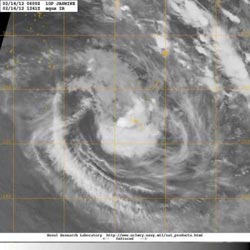NASA sees Tropical Cyclone Jasmine near Tonga

On Feb. 14, 2012 at 1241 UTC (7:41 a.m.), the MODIS instrument on NASA's Terra Satellite captured this infrared image of Cyclone Jasmine near Tonga. The strongest thunderstorms and heaviest rainfall appear to be on the northeastern quadrant of the storm. Credit: NASA/NRL<br>
When Aqua flew over Cyclone Jasmine on February 14, 2012 at 1241 UTC (7:41 a.m.), the Moderate Resolution Imaging Spectroradiometer (MODIS) instrument captured an infrared image of its clouds.
The image showed the strongest thunderstorms and heaviest rainfall appear to be on the northeastern quadrant of the storm.
A gale warning is in force for the Tongatapu group of islands. The islands are experiencing gusty winds and heavy rainfall as Jasmine creeps away slowly.
On February 14 at 0900 UTC, the Joint Typhoon Warning Center noted that Jasmine's center was just 25 nautical miles (28.7 miles/46.3 km) west-southwest of Tonga, near 21.3 South and 175.6 West.
It was bringing gusty winds and rainfall to Tonga today, and is expected to start moving away to the south at 5 knots (~6 mph/~9 kph). Jasmine's maximum sustained winds were near 45 knots (~52 mph/~83 kph) but it is expected to strengthen a little as it moves away through warmer waters.
Media Contact
More Information:
http://www.nasa.govAll latest news from the category: Earth Sciences
Earth Sciences (also referred to as Geosciences), which deals with basic issues surrounding our planet, plays a vital role in the area of energy and raw materials supply.
Earth Sciences comprises subjects such as geology, geography, geological informatics, paleontology, mineralogy, petrography, crystallography, geophysics, geodesy, glaciology, cartography, photogrammetry, meteorology and seismology, early-warning systems, earthquake research and polar research.
Newest articles

Silicon Carbide Innovation Alliance to drive industrial-scale semiconductor work
Known for its ability to withstand extreme environments and high voltages, silicon carbide (SiC) is a semiconducting material made up of silicon and carbon atoms arranged into crystals that is…

New SPECT/CT technique shows impressive biomarker identification
…offers increased access for prostate cancer patients. A novel SPECT/CT acquisition method can accurately detect radiopharmaceutical biodistribution in a convenient manner for prostate cancer patients, opening the door for more…

How 3D printers can give robots a soft touch
Soft skin coverings and touch sensors have emerged as a promising feature for robots that are both safer and more intuitive for human interaction, but they are expensive and difficult…




















